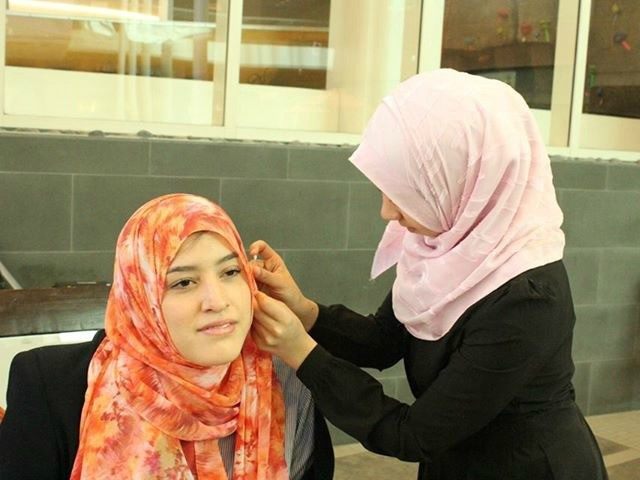Coersing, Subjugating Women
"And when ye ask of them anything, ask it of them from behind a hijab. This is purer for your hearts and for their hearts."
Koranic verse 33:53
"Oh, Prophet tell thy wives and thy daughters and the believer women to draw their jilbab close around them; this will be better so that they will be recognized and not harmed and God is the most forgiving, most merciful."
Koranic verse 33:59
"...And tell the believing women to lower their gaze and guard their chastity, and do not reveal their adornment except what is already shown; and draw their khemar over their neck ..."
Koranic verse 24:31
 |
| Facebook, Islam appreciation week at Loyola College |
Hijab, according to two women journalists in the United States born Muslim, one in Egypt the other in India, refers to an "obstacle", or "wall of separation", a "curtain", "hidden", or a "wall of separation", or "hiding" and "prevented", or "denied access to God". Nowhere, they assert, does hijab denote a scarf that modest Muslim women must wear to hide their hair from the lustful gaze of men incapable of controlling their libidos.
The women cite Arabic dictionaries to explain that jilbab refers to a "long, overflowing gown" -- which at the time the verse was written referring to it, represented the era's traditional mode of dress -- instructing women to adjust the garment to cover themselves modestly. Another word referred to is khemar which wealthy women of the time wore, as a silk scarf thrown over the head to flaunt wealth.
They speak of the domination of women by the steadily growing Islamist movement which declares it imperative that Muslim women demonstrate their chaste natures by acceding gratefully to the effect of a scarf, which has no actual tradition in Islamic dress mores, but is a construct of a patriarchal society whose interest it is to control women, to ensure that they are recognized as chattel.
And they decry the move among non-Muslim women to show solidarity with Muslim women not by helping them to set aside the hijab as a symbol of male domination and female subjugation, but by aping the use of the hijab, giving it their approval, choosing not to recognize it as a form of social and religious coersion but as a symbol of female dignity.
"We reject this interpretation [that holds the hijab a pillar of Islam] that the 'hijab' is merely a symbol of modesty and dignity adopted by faithful female followers of Islam. This modern-day movement, codified by Iran, Saudi Arabia, Taliban Afghanistan and the Islamic State, has erroneously made the Arabic word hijab synonymous with 'headscarf'. This conflation of hijab with the secular word headscarf is misleading. "Hijab' literally means 'curtain' in Arabic. It also means 'hiding', 'obstructing' and 'isolating' someone or something. It is never used in the Koran to mean headscarf."
Asra Q. Nomani and Hala Arafa
They point out that beginning in the 1980s in the wake of the Iranian Shiite revolution and the rise of Saudi Sunni Wahhabism heralding a new Islamic world of 'pure' Islam, hearking back to the time of the Prophet Mohammad, Muslim women have been bullied into believing that it is their duty as faithful daughters of Islam, to make themselves invisible.
Before the commencement of this new era of female oppression, it was rare to see a woman in Egypt, for example, wearing a head covering. Women in Arab Muslim countries have gone from wearing casual clothing similar to their Western sisters, to feeling obligated as a result of societal pressure within the new Islamism, to covering themselves for self-protection. In Afghanistan, Iran and Saudi Arabia, women are clad head-to-foot in Burqas.
There are indeed Islamic scholars who decry this new reality for Muslim women, but they go unheard. The Council on American-Islamic Relations speak on occasion of their organization as "the hijab legal defence fund", placing pressure on American companies attempting to ban their employees from wearing hijabs while in the workforce.
 |
| Photo: Daily Herald |
Mosques uniformly now consider the hijab a mandatory covering should a woman wish to enter to pray. Ultra conservative Muslim websites advance the interpretation of Muslim women being required by Sharia law to wear hijabs. Muslim women are mocked if they fail to cover their hair "Islamically". A solidarity "Walk a Mile in Her Hijab" public relations bid to normalize and support hijab-wearing has become popular.
Conservative Muslim Students' Associations tend to support the wearing of the hijab, as a required and distinguishing mark of Islam. It takes a courageous woman to set aside public opinion that has been popularized in support of women hiding their identities as though there is something shameful in fully revealing their physical presence in the company of others.

"As Americans we believe in freedom of religion. But we need to clarify to those in universities, the media and discussion forums that in exploring the 'hijab', they are not exploring Islam, but rather the ideology of political Islam as practised by the mullahs, or clerics, of Iran and Saudi Arabia, the Taliban in Afghanistan and the Islamic State.
"In the name of 'interfaith', these well-intentioned Americans are getting duped by the agenda of Muslims who argue that a woman's honour lies in her 'chastity' and unwittingly pushing a platform to put a hijab on every woman."
"Please do this instead: do not wear a headscarf in 'solidarity with the ideology that most silences us, equating our bodies with 'honour'. Stand with us instead with moral courage against the ideology of Islamism that demands we cover our hair."
Asra Q. Nomani, former Wall Street Journal reporter and Hala Arafa, former news editor, Arabic branch, Voice of America
Labels: Female Subjugation, Islamism

<< Home